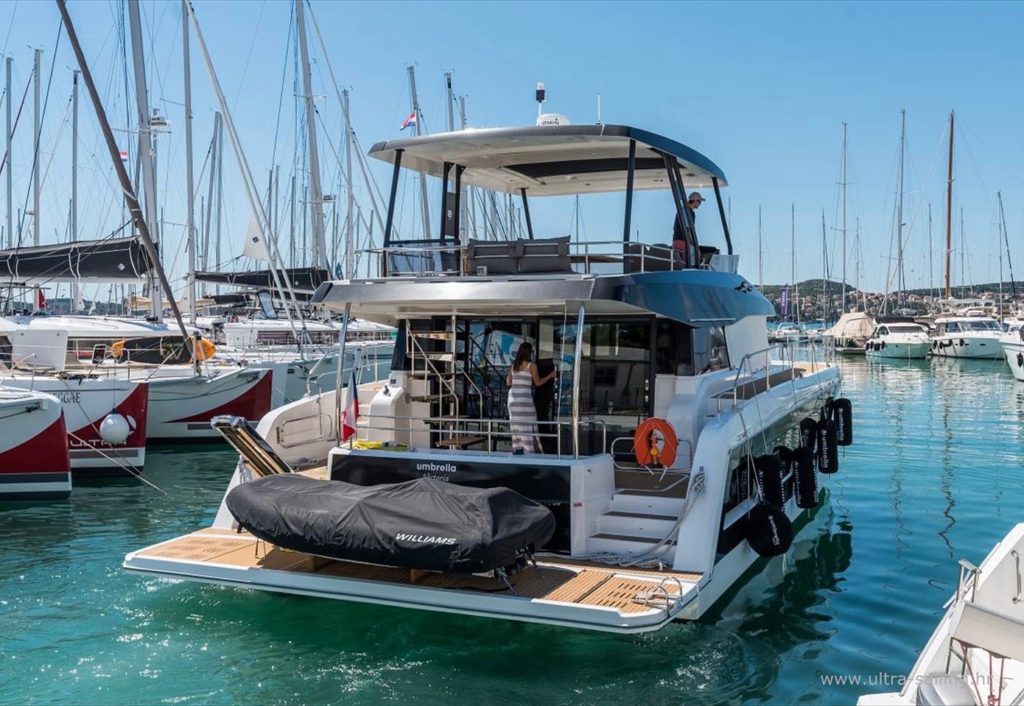There are different lifting systems for tenders on catamarans. The main ones are the pole system, the davit system, the gantry, the sliding platform and the tenderlift.
Spinnaker pole system
The spinnaker pole system is a system that consists of a spinnaker pole that comes out of the boom, stabilized in the center of the boat and on which is placed a hoist with which the dinghy can be raised manually or by returning the lifting end to a winch .
There are similar removable crane systems in stainless steel or carbon. For some, they can be motorized. These solutions have the advantage of being light and inexpensive for the simplest versions. Small flat on the costs on the motorized carbon versions. However, this solution requires at least two people, one raising the dinghy and the other stabilizing it. In case of swell or moderate wind it would even be necessary to be 3 people because the tender is lifted only by a central point. It will therefore have to swing very strongly from one side to the other. For tenders exceeding a certain weight, raising it can even become dangerous or even unthinkable.
From a space point of view, the system in the boom does not require too much installation but only a free space for the passage of the lifting line. Systems of the removable crane type require a modification of the deck of the boat which will also require significant structural reinforcements.


Davit solution
The davit solution has been the most common lifting solution in recent years. It consists of two prominent arms installed between the two hulls and on the transom of the cockpit. The dinghy is raised at the bow and stern by a rope which circulates inside them and which generally joins a winch which is most often electric. The davits can be made of different materials: stainless steel, carbon or aluminium. They have the advantage of being relatively light, however they can hardly be adapted to tenders or boat structures that differ from the specifications for which they were designed. In the same way as for the previous solution, lifting the tender often requires having to be at least 2 people, one alternately lifting the nose or the back of the dinghy and another holding it to limit movement back and forth. In heavy seas, this solution requires some experience.
The gantry solution
There is also the solution of the gantry to raise the tender from the water. This solution has become quite common for half a dozen years and more particularly on small boats (40/45 feet), but it is sometimes seen on slightly larger boats. It consists of a metal structure of the arch type, fixed to the base of the cockpit pillars and pivoting upwards thanks to a line connected to a winch or a winch (manual or electric). This solution has the advantage over the previous one of being able to be operated by a single person. She also has a moderate weight but has a big disadvantage which is to have the tender in the high position literally obstructing the view of the sea from the cockpit. It is also a fairly invasive metal structure visually and aesthetically speaking.


Sliding system
As for the sliding system, this system is generally electric or hydraulic and consists of a platform whose brackets supporting it will move up and down using an endless rod, or thanks to a cylinders. The system is made of 316L stainless steel. The structural forces being quite significant, the lifting capacity is severely limited. Moreover, still for the same reason, the depth of the platform (from the rear to the front) is also limited and therefore also restricts the width and size of the tender. The platform being fixed, it requires keeping the outboard motors of the tender raised, which reduces its maximum possible length. Finally, the system requires a particular hull shape and substantial structural reinforcements. The sliding device is a rigid device subject to the dynamic forces of the boat.
The tenderlift
Finally there is also the tenderlift system, it responds to a very particular and patented movement kinematics which allows to reduce the structural efforts on the device and on the boat in a consequent way. This allows the device to be able to be made of aluminum and to be able to maintain relatively low weight characteristics. The lifting system being with straps (or strops) it retains freedom of movement, again limiting dynamic structural forces. With a modular structure, the device easily to all shapes of hulls or nacelles. The tray can also have an infinite number of shapes with removable parts. Finally, accessorizing the device is easy (remote control, lighting, safety chain, retractable cradles, etc.). The platform is a perfect extension of the living space on board, whether from the cockpit to the transoms, out of the water, the tender blends into the living space of the boat.











